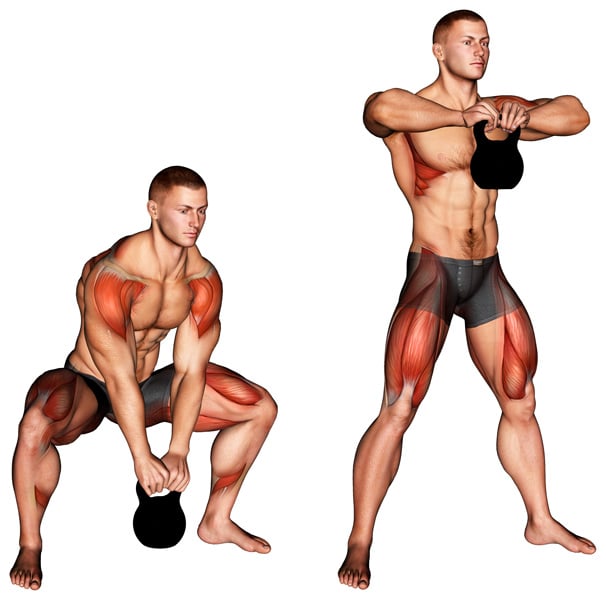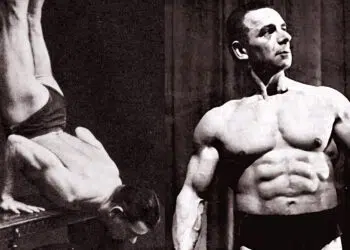The kettlebell sumo high pull (or kettlebell sumo deadlift high pull) is a functional exercise that also builds strength and muscle throughout the entire body. It combines a deadlift and upright row, and, therefore isn’t just a simple movement which is why it’s so effective.
Consequently, it’s not the best option for beginners to try right out of the gate but with a little training experience, it can be a powerful choice in helping you to become more fit.
Check out our guide that explains muscles involved, movement execution, tips, benefits, variations, and how to include this exercise in your workouts.
Summary
If you want to be fitter, then the kettlebell sumo high pull is an exercise you should consider adding to your workout regime. It’s a total body movement that emphasizes the upper posterior muscles. In this guide, you’ll learn what muscles are involved in this movement, how to do it, what the benefits are, variations you can do, and more.
How To Do The Kettlebell Sumo High Pull
There are various elements to this movement which means it’s not as simple to do as a biceps curl, for example. It’s also the best exercise for beginners as they should learn to do all of the parts involved before attempting this full-body lift.
We recommend doing a few sets of light shoulder lateral raises and dumbbell presses to warm up the shoulder joints.
Here are exercise instructions for the sumo high pull.
Level Up Your Fitness: Join our 💪 strong community in Fitness Volt Newsletter. Get daily inspiration, expert-backed workouts, nutrition tips, the latest in strength sports, and the support you need to reach your goals. Subscribe for free!
- Choose your kettlebell and place it on the floor so that you can grip it with both hands.
- Stand over the kettlebell with feet wider than the shoulders and toes pointed slightly outward. Push your knees forward slightly over the feet toward the toes.
- Keeping your back straight and shoulders back, squat down just far enough to where you can grab the kettlebell with both hands.
- Press your feet into the ground to get a good grip and imagine you’re turning them outward but don’t actually allow your feet to move.
- Keep your shoulders back, core tight, and squeeze your lat muscles before you do the movement.
- Triple extend the ankles, knees, and hips, bringing the hips forward as you stand up, and pull the kettlebell up until the handle is about level with your chin. Keep the elbows back and not forward in front of you.
- Bring the kettlebell back down to the floor by reversing the motion and repeat the movement at a quick pace as shown in the video below.
Here’s a video example of this exercise…
Kettlebell sumo high pull tips
- It’s okay to bring the knees forward over the feet to help keep your balance and generate enough power to execute the exercise.
- The exercise should be performed in a fluid motion at a decent pace. The lift and pull should be as efficient as possible.
- Because this exercise involves internal rotation of the shoulders, you should be careful as to not use too much weight or neglect perfect form.
Kettlebell Sumo High Pull Benefits
There are so many benefits to doing this exercise which we’ve included below.
Strengthen your posterior chain
The sumo high pull is posterior chain focused because it includes a deadlift and pulling component. That means it will work all of the rear muscles including hamstring, glutes, back, and rear deltoids too. But the quads and core muscles also get a great workout. Many focus too much on pushing exercises which causes muscular imbalance and this exercise may be just what you need to ensure you’re well balanced.
Great time saving/one kettlebell one exercise movement
Whether you’re very short on time but still need to get in a workout or you want to do one exercise using a kettlebell, the sumo high pull could certainly fit either role quite well.
It works almost the entire body and is overall very beneficial.
Improve lifting posture
Deadlifts, squats, and other total body lifts are important because they teach and reinforce good lifting posture. This is crucial to lifting heavy and making gains but also preventing injuries.
Not to mention, they strengthen the upper back muscles that help us to maintain a good walking posture in and out of the gym.
Improve functional fitness
While you can stimulate muscle growth and get stronger by doing this movement, it’s actually more of a functional fitness exercise and something you’d see CrossFitters doing.
It’s functional for so many reasons including boosting coordination, learning body awareness, moving how the body is designed to move, strengthening your muscles, improving joint stability, and more.
Read also: Functional Strength Training: What It Is, How to Do It, and How It Will Radicalize Your Workouts
Burn more calories/lose body fat
The sumo high pull is somewhat of a faster-paced movement compared to other exercises. It also involves the entire body and most muscles which means it burns more calories – a key component of weight loss.
Done safely, it can be a great way to improve your physique while also improving your cardiovascular fitness.
Related: 5 Awesome Benefits Of Sumo Deadlift High Pulls
Kettlebell Sumo High Pull Drawbacks
We have a few gripes with the kettlebell sumo high pull. However, we still think it’s a great exercise.
Involves multiple lifts/not ideal for beginners
about the kettlebell sumo high pull it would be that it involves multiple components such as the deadlift and high pull. It’s not the best choice for beginners because they need to understand how to do these specific movements safely and correctly.
Not the best for shoulder health
So the sumo high pull and its variation do involve internal rotation of the shoulder. This doesn’t necessarily mean it will cause an injury but you should pay proper attention to form and not use heavy weights for this exercise relative to your strength ability.
Kettlebell Sumo High Pull Variations
While the kettlebell sumo high pull is a great exercise no doubt, there are some variations that you can do to vary your training.
Barbell/dumbbell high pull
Don’t have a kettlebell? Maybe you don’t like training with kettlebells, or maybe you want to use more weight for this exercise? You can use a barbell or dumbbells instead. And actually, these are more common training tools anyhow.
Level Up Your Fitness: Join our 💪 strong community in Fitness Volt Newsletter. Get daily inspiration, expert-backed workouts, nutrition tips, the latest in strength sports, and the support you need to reach your goals. Subscribe for free!
Using Kettlebell Sumo High Pull In Your Training
It’s exercises like these that make us excited to train because they are different from a lot of the boring and monotonous movements that we tend to do most of the time.
Involving the whole body, the sumo high pull also includes an explosive and athletic element that makes people look forward to training.
Here are some ways we would incorporate this exercise in our workouts.
CrossFit workouts
People who do CrossFit or similar training will often incorporate similar exercises. After all, it is functional fitness and the kettlebell sumo high pull will only benefit your progress.
Circuits
Circuit training involves performing several exercises one after the other with little to no rest in between. This is one of the exercises we’d add in because it’s challenging, keeps your heart rate up, and burns calories.
Straight sets
You actually don’t have to do a special workout to do this exercise. You can do the standard 3-4 sets with 30-60 seconds rest in between. This may also be the best option if you’re using heavy kettlebells because it will allow you to take longer rests in between and focus on increasing the poundages.
Sets and reps
There’s no perfect strategy here as you should train according to your goals. Although, we do recommend most people use a moderate to high rep range to protect the shoulder joint. Here are our set and rep recommendations depending on what your focus is.
- For strength and hypertrophy – 3 sets x 8-15 reps
- For muscular endurance/functional fitness – 3 sets x 15-35 reps
Muscles Worked

Infraspinatus
Helping to form the shoulder joint along with several other muscles, infraspinatus is a rotator cuff muscle and hence contributes to the the joint’s stability and motion. The infraspinatus muscle, in particular, assists in external rotation and scaption as well as lateral rotation of the humerus.
Latissimus Dorsi
The latissimus dorsi is a significant muscle because it’s the largest one in the upper body, covering parts of the upper and lower back. When you perform a pull-up or lift a weight from low to high you’re using the lat muscles.
Teres Major
Attaching to both the shoulder blades and upper arm, the teres major is a back muscle that assists in extension and medial rotation of the upper arm. Unlike the teres minor, major does not connect to the shoulder capsule and is therefore not a rotator cuff muscle.
Teres Minor
The teres minor is one of the rotator cuff muscles that helps to keep the head of the upper arm in the shoulder cavity so the deltoids can move freely.
Trapezius muscles
Starting from the base of the neck, the trapezius muscles are rather large reaching from one side of the shoulders to the other and down to the middle of the back. From top to bottom there are three sections of muscle fibers – upper, middle and lower.
Upper fibers lift the scapula, middle fibers retract the shoulder blades and lower fibers depress the scapula work with the upper fibers to lift the scapula.
Brachialis
Pulling and curling variations work the brachialis, a muscle that goes from the outer upper arm under the biceps down into the forearm. It’s a strong elbow flexor but can also supinate and pronate the forearm.
Brachioradialis
The brachioradialis muscles are located on the top side of the forearm when the forearms are facing down. They consequently have a part in rotating the forearms but also bend the arm at the elbow like the brachialis.
Deltoid Posterior
Posterior deltoids are on the backside or posterior of the upper body. Pulling your elbows back behind your body uses the rear delts.
Leg muscles
The kettlebell sumo high pull requires use of all leg muscles, including the gluteus maximus, quadriceps, hamstrings, and calves. These muscles allow us to drop down into a squat and stand back out of it.
Core
The deep core muscles like the transverse abdominis allow us to draw the belly button into the spine, helping to stabilize the trunk during various lifts. This maximize our strength potential and protects the lower back.
Wrapping Up
The kettlebell sumo high pull deserves a spot in your current workout routine because it has many benefits that you can read about in this guide.
It’s more of a functional fitness type exercise that trains most muscles and especially the ones on your backside like hamstrings and glutes, core, back, and shoulders too. Whether you do CrossFit, play sports, or want to become more fit, definitely make this movement a regular in your training regime.
If you want to improve your sumo deadlift, check out our complete guide on this total-body strength-focused lift.
Interested in measuring your progress? Check out our strength standards for Upright Row, Deadlift, Sumo Deadlift, and more.








